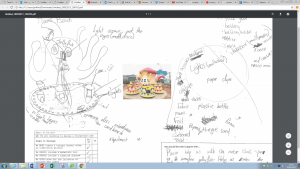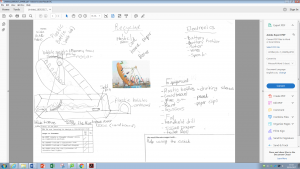Day 3: Our first school visit
The structure of the sessions was as follows:
Roles:
Dan: Load files on USB, load PowerPoint presentation.
Dave: Introduce teachers and project.
Alex: Set up video and camera. Document as much as possible throughout lesson especially when Dave is introducing Crumble to small groups.
0 – 5 mins: Introduction to the project and the teachers (Dave)
5 – 10 mins:
Hand out models – on your tables, discuss:
How does the ride work?
How was it made?
What materials have been used?
What do you like about the design?
What could be improved?
10 – 15 mins: By the end of the session….. (Using A3 thought shower as an example)
15 – 35 mins: Introduce and complete the task. (Dave goes from table to table with laptop and introduces Crumble to assess and introduce)
Dan – stop class every now and again to discuss key ideas and address misconceptions
35 mins: Show them how to self-assess and complete sentence: ‘We would like some extra help with…..’ (Dan)
DT reflections:
The designs show that learners all met the success criteria and created a design and materials list with considerations for the inclusion of lights. It was clear that learners would require as many examples as possibles and instruction on how a circuit works and how to create one. We would need to source all the materials and tools.
Computing reflections:
As the class were planning, I supported groups with design elements and fielded questions while Dave worked his way around the groups with a laptop and crumble set up. Learners has prior experience of Scratch and therefore, were able to transfer that understanding to using this software. We soon discovered that learners were most effectively supported through providing brief instruction and then allowing learners to explore the program themselves and debug accordingly (with adult on standby for support and questioning) in accordance with good practice in computing.
Attached is a video of my role in facilitating the learning by modelling and sharing ideas throughout the design process:



